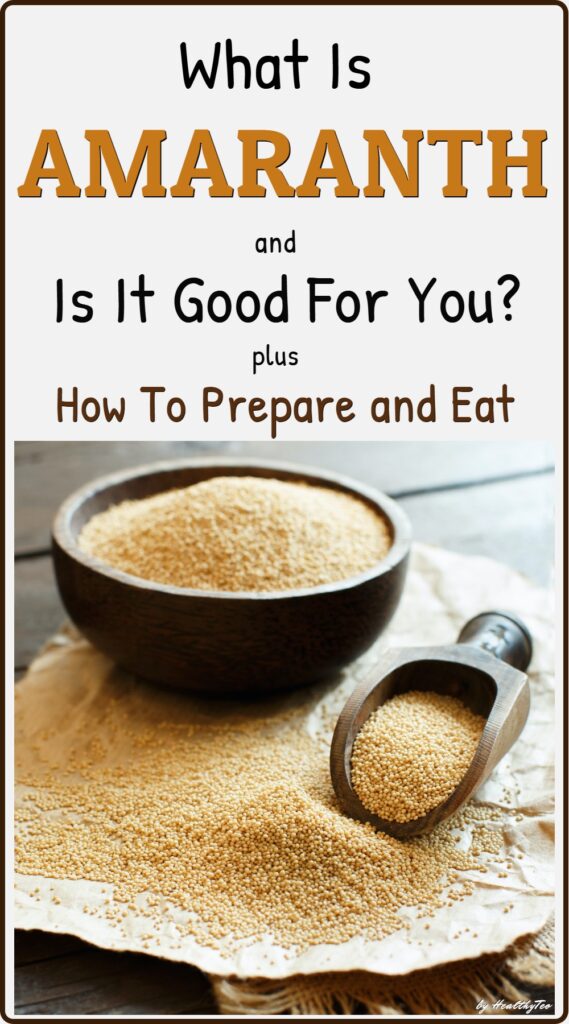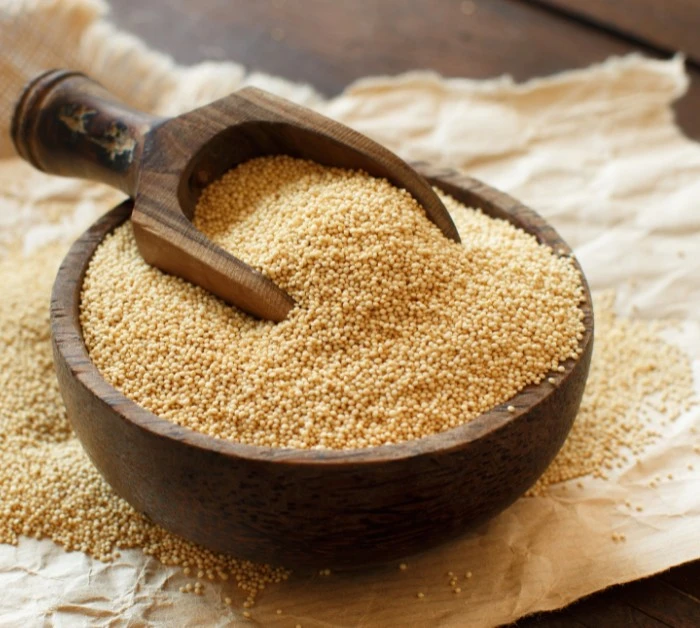This gluten-free grain is extremely nutritious and may be easily incorporated into your diet for breakfast, lunch, or dinner. See why amaranth is good for you and how to prepare it!
Before we get into the benefits of amaranth and the potential side effects of consuming this grain, let’s first go over the fundamentals and see what it is and where it comes from.
This post may contain affiliate links, which means we may receive a small commission, at no cost to you, if you make a purchase through a link. For more information, please see our disclosure.
What is Amaranth?
Amaranth is the common name for around 60 different species of grains that have been cultivated for over 8,000 years.
Technically, amaranth is categorized as a pseudocereal (like quinoa). This means that, while it is not technically a cereal grain like wheat or oats, it contains a comparable set of nutrients and is used in similar ways.
Amaranth is still the native crop of Peru, and it is grown in South America, North America, India, China, Russia, and Africa. It is a key ingredient in traditional breakfast porridge in places like India, Mexico, and Nepal.
It’s a tall plant with broad green leaves and vibrant purple, red, or gold flowers. The leaves of amaranth are also valuable, though far less popular than the grains themselves.

Amaranth is popular among gluten-free diet followers. This gluten-free grain is also high in protein, fiber, micronutrients, and antioxidants.
Nutrition facts
According to the USDA, one cup (246g) cooked amaranth grain has about:
- Calories: 251
- Protein: 9.35 grams
- Fat: 3.9 grams
- Carbs: 46 grams
- Fiber: 5.17 grams
- Manganese: 2.1mg (105% of the RDI)
- Magnesium: 160mg (40% of the RDI)
- Phosphorus: 364mg (36% of the RDI)
- Iron: 5.17mg (29% of the RDI)
- Copper: 0.36mg (18% of the RDI)
- Vitamin B6: 0.28mg (14% of the RDI)
- Calcium: 116mg (12% of the RDI)
- Potassium: 332mg (9% of the RDI)
*RDI – Recommended Dietary Intake: the average daily intake level of a particular nutrient that is likely to meet the nutrient requirements of 97-98% of healthy individuals in a particular life stage or gender group.
Why is amaranth so good for you?
Rich in protein
Amaranth has high-quality protein, with 9 grams per cup of cooked grains. It contains lysine, an amino acid that is lacking in many other comparable grains. It also contains more of the amino acids cysteine and methionine than typical cereal grains such as rice and maize.
Including protein in our diet is one of the most reliable ways to keep our bodies toned, developed, and functioning properly. Because of its unusually high quantities of plant protein, amaranth grain is an excellent addition to the diet for promoting healthy cell, muscle tissue, and skin growth.
It’s naturally gluten-free
While many of the most popular grains contain gluten, amaranth is naturally gluten-free and can be enjoyed by people following a gluten-free diet.
Gluten is a protein present in grains such as wheat, barley, rye, and spelt. Gluten sensitivity is a group of symptoms related to a reaction to this protein.
Gluten triggers an immune response in those who have celiac disease, causing damage and inflammation in the body. Those who are gluten sensitive may also have unpleasant symptoms such as bloating, gas, and diarrhea.
Gluten-free grains such as amaranth, quinoa, and nutritious buckwheat are included in a gluten-free diet.
Improves digestion
Amaranth stimulates the digestive system and helps regulate the excretion of bodily waste due to its high fiber content (5.17 grams per one cup-246g of cooked amaranth).
According to a study published in Food Chemistry, 78% of the fiber in amaranth is insoluble fiber and 22% is soluble fiber, which is a higher proportion than that found in wheat and maize.
Dietary fiber can help improve digestion and eliminate constipation, bloating, and cramping. It also aids in nutrient uptake efficiency, which is a very important effect of dietary fiber due to the high concentration of nutrients in the grain.
Improved weight control
Whole grains are your friend if you’re trying to lose or maintain a healthy weight. The protein and fiber in amaranth can help you feel full and satisfied after eating, and the protein helps maintain muscle mass for a healthy metabolism.
A high-protein breakfast was found to lower levels of ghrelin, the hormone that stimulates hunger, in a small study published in The American Journal of Nutrition. Another study of 19 people found that a high protein diet reduced appetite and calorie intake.
Furthermore, the fiber in amaranth may move slowly and undigested through the gastrointestinal tract, promoting feelings of fullness. According to a 2009 study, increased fiber intake was associated with a lower risk of gaining weight and body fat.
Of course, there are numerous factors that contribute to overall weight gain or loss. Still, more research is needed to investigate the effects of amaranth on weight loss.
However, it is always best to combine amaranth with a balanced diet and increased physical activity.
May help lower cholesterol levels
A higher intake of whole grains, including amaranth, has been linked to a lower LDL cholesterol level. Amaranth oil was found to reduce total and “bad” LDL cholesterol by 15% and 22%, respectively, in one animal study. Additionally, amaranth grain decreased “bad” LDL cholesterol while raising “good” HDL cholesterol.
Amaranth fat content varies depending on species and genotype. Researchers credit the lipid-lowering benefit to greater quantities of fatty acids such as palmitic acid, oleic acid, and linoleic acid, as well as high levels of the unsaturated hydrocarbon squalene.
Despite these encouraging findings, more research is needed to determine how amaranth affects cholesterol levels in individuals.
Potential side effects of amaranth grain
If you don’t eat a lot of fiber-rich foods, you may experience digestive discomfort when you start. To avoid issues, gradually introduce high-fiber foods into your diet, and drink plenty of water to aid with fiber digestion.
Amaranth may cause diarrhea and stomach pain in persons who are sensitive to lysinuric protein.
Furthermore, because of its ability to lower insulin levels, eating too much amaranth grain may be dangerous for persons with hypoglycemia. In this situation, caution is required.
There is insufficient trustworthy evidence regarding the safety of taking amaranth while pregnant or breastfeeding. Avoid using it to be on the safe side.
Allergies
There have been a few reports of anaphylaxis caused by an amaranth allergy, however, researchers note that this is an extremely rare reaction.
An amaranth allergy can develop symptoms within minutes or up to an hour after eating the grain. If you think you could be allergic to amaranth, consult your doctor.
Although amaranth allergies are rare, they do occur. If you have a grain allergy, you may be more sensitive to amaranth.
Because amaranth is a gluten-free grain, it may be suitable for those with celiac disease or a non-celiac sensitivity to gluten. However, because cross-contamination is always a possibility, you should always read the label of the food you choose.
*Note – Before adding a new food into your diet, always consult with your doctor or a qualified nutritionist.
How to prepare and eat amaranth
Amaranth is easy to cook and can be used in a variety of cuisines.
To cook amaranth, combine amaranth and water in a 3:1 ratio.
Three cups of water should be used for every cup of amaranth. In a medium-sized pot, heat the water-grain mixture until it begins to boil. Once it begins to boil, reduce the heat and let it simmer for 20-30 minutes, or until all of the water has been absorbed.

Amaranth is widely available in health food stores. You can also purchase amaranth from Amazon here.
If you have time you can also sprout your amaranth before cooking. When you sprout grain-like amaranth, it helps to:
- make food more digestible
- boost nutritional absorption
- reduce phytic acid
- boost enzymes and antioxidants
You can sprout it by soaking it in water for one to three days and then letting the grains germinate. Here are the instructions for sprouting amaranth seeds correctly.
Because of its nutty and toasted flavor, this ancient grain complements a wide range of recipes, from breakfast to dessert.
Here’s how to include amaranth into your daily diet:
- Use it anywhere you’d use quinoa, oatmeal, or rice
- For breakfast, combine amaranth, nuts, fruits, and probiotic yogurt.
- Mix in soups and stews.
- To make gluten-free baked goods, use amaranth flour.
- Amaranth can be served as a side dish or combined with vegetables and another protein source to produce a complete and balanced meal.
Here are some vegetarian amaranth recipes provided by Naturally Ella.

Disclaimer: While we have looked into the research on the health benefits of this food, this is only for informational purposes and should not be construed as medical advice. Those with health-related questions should seek the advice of a medical professional.




